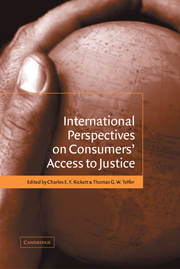Book contents
- Frontmatter
- Contents
- List of contributors
- Preface
- Table of cases
- Table of statutes
- 1 Consumers' access to justice: an introduction
- Part I Perspectives on consumers' access to justice
- Part II Issues in contract and tort
- Part III Services and the consumer
- Part IV Consumer bankruptcy law
- 10 Access to the discharge in Canadian bankruptcy law and the new role of surplus income: a historical perspective
- 11 The death of consumer bankruptcy in the United States
- Part V Procedure and process issues
- Part VI Conflict of laws issues
- Index
10 - Access to the discharge in Canadian bankruptcy law and the new role of surplus income: a historical perspective
from Part IV - Consumer bankruptcy law
Published online by Cambridge University Press: 11 July 2009
- Frontmatter
- Contents
- List of contributors
- Preface
- Table of cases
- Table of statutes
- 1 Consumers' access to justice: an introduction
- Part I Perspectives on consumers' access to justice
- Part II Issues in contract and tort
- Part III Services and the consumer
- Part IV Consumer bankruptcy law
- 10 Access to the discharge in Canadian bankruptcy law and the new role of surplus income: a historical perspective
- 11 The death of consumer bankruptcy in the United States
- Part V Procedure and process issues
- Part VI Conflict of laws issues
- Index
Summary
Introduction
While Canadian debtors have never had an unconditional entitlement to a discharge in bankruptcy, Canadian courts have long recognised the important function that the discharge plays in the rehabilitation of the debtor. The Canadian discharge, originally based upon the English model, has differed from the American concept of fresh start in that Canada has traditionally relied on judicial discretion to impose conditions or limitations on the order of discharge in appropriate circumstances. Although the courts in Canada have had the ability to impose conditional discharges upon bankrupts, including requirements to pay money from future income, conditional discharges under the traditional regime are only one option and courts have had the discretion to grant an unconditional discharge where it has been merited. The often cited rationale for the release of debts is that it permits the debtor's ‘rehabilitation as a citizen, unfettered by past debts’. The discharge, it is argued, allows the debtor to once again become a productive member of the open market economy.
More recently, however, there has been a reconceptualisation of the role of the discharge in bankruptcy law and perhaps more broadly a new view of debtor rehabilitation has emerged. The rising number of consumer bankruptcies over the last decade led many to claim that something must be done to stem the rising tide. The assumption was that many debtors could really afford to pay more to their creditors and that the bankruptcy regime was too easy on debtors.
- Type
- Chapter
- Information
- International Perspectives on Consumers' Access to Justice , pp. 231 - 263Publisher: Cambridge University PressPrint publication year: 2003
- 2
- Cited by



